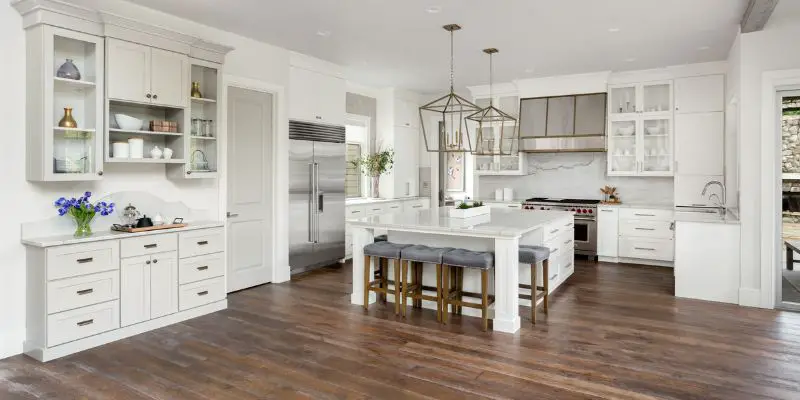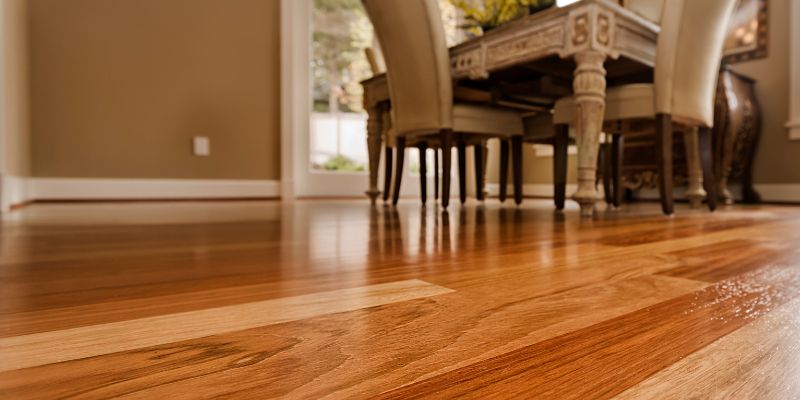Run the hardwood floors parallel to the longest wall in the room for the best direction. When installing hardwood floors, it is important to consider the direction of the planks to create a visually appealing and balanced look.
To achieve this, the general recommendation is to run the planks parallel to the longest wall in the room. This helps to elongate the space and allows for a natural flow throughout the area. However, there are other factors to consider, such as the layout of the room and the direction of natural light.
By carefully assessing these elements, you can determine the best direction to run your hardwood floors for a stunning and harmonious result.
2. Choosing The Right Direction For Hardwood Floors
When it comes to installing hardwood floors, one of the most important decisions you’ll need to make is the direction in which they will run. The direction of your hardwood floor can have a significant impact on the overall look and feel of your space. To help you make the best choice, consider the following factors.
2.1 Consider The Layout And Flow Of The Room
The layout and flow of your room play a crucial role in determining the direction of your hardwood floors. Start by analyzing the shape and size of the space. Is it long and narrow or wide and open? Understanding the layout will help you determine the best direction to run the planks.
For long and narrow rooms, running the planks parallel to the longest wall can create an illusion of width, making the room appear more spacious. On the other hand, in open-concept spaces where multiple rooms are connected, running the planks parallel to the sight line or the direction in which people will be entering the room can enhance the flow and continuity.
2.2 Assess Natural Light And Room Size
Another factor to consider when choosing the direction of your hardwood floors is the natural light in the room. Light plays a significant role in how the wood grain is perceived. If your room receives ample natural light, running the planks perpendicular to the light source can showcase the natural beauty and unique patterns of the wood.
Additionally, the size of the room can also influence your decision. In smaller spaces, running the planks diagonally or on a diagonal angle can create an aesthetically pleasing look, making the room feel more expansive and dynamic.
2.3 Determine The Subfloor Direction
When installing hardwood floors, it’s crucial to take into account the direction of the subfloor. The subfloor should always run perpendicular to the floor joists for optimal stability and support. Therefore, the direction of your hardwood floors should be aligned with the subfloor direction.
In conclusion, choosing the right direction for your hardwood floors requires careful consideration of the layout, flow of the room, natural light, room size, and subfloor direction. By taking these factors into account, you can ensure the installation of hardwood floors that not only aesthetically enhance your space but also provide long-lasting durability.

3. The Different Direction Options
Discover the various options for running hardwood floors, ensuring a unique and visually appealing direction that fits your space perfectly. Experiment with different layouts to create a stunning and personalized look for your home.
When installing hardwood floors, choosing the right direction is crucial for both the aesthetic appeal and functionality of your space. There are three main direction options to consider, each offering a unique look and feel to your room. Let’s explore these options in more detail.
3.1 Running Parallel To The Longest Wall
One direction option is to run the hardwood flooring parallel to the longest wall in the room. This is a popular choice as it creates an elongated appearance, making the room feel more spacious. It also provides a clean and straightforward look, enhancing the overall symmetry of the space.
3.2 Running Parallel To The Width Of The Room
Another option is to run the hardwood flooring parallel to the width of the room. This direction can help emphasize the width of the space, particularly in narrow rooms. It adds visual interest by contrasting the length of the boards against the width, providing a unique and dynamic look to your flooring.
3.3 Diagonal Direction
For those seeking a bold and eye-catching design, running the hardwood flooring diagonally is the way to go. This direction creates a sense of movement and adds a touch of flair to any room. The diagonal pattern can help make a small room appear larger while adding a touch of sophistication.
One important consideration when opting for a diagonal direction is the increased complexity of installation. It requires more precise measurements and cutting, so professional installation is recommended.
Deciding on the right direction for your hardwood floors can significantly impact the overall look and feel of your space. Consider the unique characteristics and layout of your room, and choose the direction option that best suits your style and desired outcome.
4. Factors To Consider
Before installing hardwood floors, there are several important factors to consider. These factors will play a crucial role in determining the direction in which your hardwood floors should run. By carefully considering each factor, you can ensure that your hardwood floors not only look visually appealing but also enhance the overall functionality and structural integrity of the space. Let’s explore these factors in detail.
4.1 Visual Appeal And Aesthetics
When deciding on the direction to run your hardwood floors, visual appeal and aesthetics should be a top consideration. The direction of the wood planks can significantly impact the overall look and feel of the room. Horizontal installation can make the space appear wider, while vertical installation can make it appear longer. Additionally, the direction should align with the flow of the room and complement the existing architectural features.
4.2 Natural Light And Room Brightness
The amount of natural light and brightness in the room is another crucial factor to consider. Running hardwood floors perpendicular to the source of natural light can help to enhance the brightness and make the space feel more open. This direction allows the sunlight to flow across the planks, creating a visually pleasing effect. Alternatively, running the floors parallel to the natural light can create a cozy and intimate atmosphere in rooms with limited sunlight.
4.3 Structural Integrity And Subfloor
The structural integrity of the space and the condition of the subfloor should also play a significant role in determining the direction of the hardwood floors. Running the planks perpendicular to the floor joists can provide additional support and prevent sagging or warping over time. Additionally, if there are any existing issues with the subfloor, such as unevenness or moisture problems, the direction of the flooring installation should be adjusted to address these concerns.
4.4 Flooring Types And Patterns
The type and pattern of the flooring can influence the direction of the installation. For example, with wide or long planks, running the floorboards parallel to the longest wall can showcase their beauty and create an aesthetically pleasing effect. However, with narrow or short planks, running them perpendicular to the longest wall can give the illusion of a wider space. Consider the characteristics of your chosen flooring type and pattern to determine the most suitable direction.
4.5 Personal Preference And Style
Ultimately, personal preference and style should also factor into the decision-making process. Your own taste and the desired style of the room can guide the direction of the hardwood floors. Consider your furniture placement, the overall design scheme, and your personal aesthetic preferences. By aligning the direction with your style, you can create a cohesive and visually pleasing space that reflects your unique taste.
5. Step-by-step Guide To Determine Direction
Choosing the right direction for your hardwood floors is essential to create a harmonious and visually appealing space. With so many factors to consider, it can be overwhelming to determine the ideal direction. That’s why we’ve put together this step-by-step guide to help you make an informed decision.
Before you start planning the direction of your hardwood floors, it’s crucial to accurately measure the dimensions of the room. This will help you determine how the planks will align with the space and ensure a seamless installation. Measure the length and width of the room using a tape measure and record the dimensions for future reference.
Natural light and room features play a significant role in the overall appearance of your hardwood floors. Take a moment to evaluate the amount of natural light that enters the room. Lighter hardwood floors tend to make a space feel more open, while darker options add warmth and coziness. Additionally, consider any permanent fixtures or architectural elements in the room, such as fireplaces or built-in shelving. These features may influence the direction of your flooring.
The direction of your subfloor can impact the direction of your hardwood floors. Ideally, the hardwood planks should run perpendicular to the floor joists for optimal stability. To determine the subfloor direction, locate the floor joists underneath the existing flooring or consult your builder’s plans if available. Keep in mind that exceptions may apply in certain cases, such as when working with a concrete subfloor or installing engineered hardwood.
The type and pattern of the hardwood flooring you choose can also influence the direction of installation. Some flooring types, like parquet or herringbone, have a specific orientation that creates unique patterns. Similarly, wider plank flooring may look best when installed parallel to the longest wall in the room. Take into account the specific characteristics of your chosen flooring type and pattern when determining the direction.
To ensure you make the right decision, spend some time visualizing and testing different directions. Use spare flooring planks or samples to lay out the potential directions and observe how they interact with the room. Pay attention to how the grain and texture of the wood align with the space and consider furniture placement. This step allows you to see firsthand how different directions may impact the overall aesthetic of the room.
6. Tips And Tricks
When it comes to installing hardwood floors, selecting the right direction is crucial for creating a visually appealing and seamless look in your space. In this section, we will explore some tips and tricks to help you determine the best direction for your hardwood floors. Whether you want to transition between different flooring materials, incorporate borders and accents, or create unique patterns and designs, these ideas will inspire you to make the most of your hardwood flooring project.
6.1 Transition Techniques For Direction Changes
Transitioning between different flooring directions can be a challenge, but with the right techniques, you can achieve a flawless look. Here are some practical tips to consider:
- Use a threshold or T-molding: When changing directions between rooms or areas, consider using a threshold or T-molding to create a smooth transition. This will not only provide a visual break but also help prevent potential damage to the floor’s edges.
- Follow the longest line: In open floor plans, it’s best to align the hardwood planks with the longest wall. This creates a sense of continuity and visually expands the space.
- Avoid transitions in high-traffic areas: To maintain a consistent flow, it’s advisable to avoid transitioning the direction of your hardwood flooring in high-traffic areas, such as hallways or main walkways.
6.2 Using Borders And Accents To Enhance Direction
Adding borders and accents to your hardwood floors can elevate the overall aesthetic and accentuate the direction you choose. Consider the following ideas:
- Contrasting color borders: By incorporating a border with a contrasting color or wood species, you can add a distinctive edge to your hardwood floors.
- Inlayed patterns: Create captivating designs by using contrasting or complementary wood species to form inlay patterns within your hardwood floor. This not only elevates the direction but also adds visual interest and uniqueness to your space.
6.3 Creating Unique Patterns And Designs
If you’re looking to make a bold statement or achieve a truly unique look, explore the possibilities of creating patterns and designs with your hardwood floors:
- Herringbone or Chevron pattern: These classic patterns add elegance and sophistication to any space. By arranging the planks in a diagonal or V-shape, you can create a timeless and visually striking effect.
- Parquet flooring: Parquet flooring consists of intricate geometric designs made from tiles or individual wood pieces. This technique offers limitless design options, allowing you to create customized patterns that reflect your personal style.
- Random or mixed-width planks: For a more casual and eclectic look, consider installing hardwood planks with varying widths or arranging them randomly. This creates a dynamic pattern that adds character and charm to your flooring.

7. Common Mistakes To Avoid
When installing hardwood floors, it’s important to avoid common mistakes, such as not considering the direction in which the boards should run. By understanding the proper direction for your hardwood flooring, you can ensure an aesthetically pleasing and long-lasting result.
When installing hardwood floors, it’s important to be mindful and avoid common mistakes that can impact the overall outcome and longevity of your flooring. By being aware of these potential pitfalls, you can ensure a successful installation that adds beauty and value to your home. Let’s take a closer look at some of the most common mistakes to avoid:
7.1 Ignoring The Subfloor Direction
One of the primary mistakes homeowners make when installing hardwood floors is ignoring the direction of the subfloor. The subfloor’s direction plays a crucial role in the overall stability of the flooring. It’s essential to consider the direction of the subfloor and lay the hardwood planks perpendicular to it for maximum strength and durability. By doing so, you can prevent sagging, buckling, and other issues that may arise over time.
7.2 Neglecting Natural Light And Room Features
Natural light and room features can significantly influence the overall appearance of your hardwood floors. Neglecting these important factors can result in an uneven and unappealing aesthetic. When choosing the direction to run your hardwood floors, consider the placement of windows and the flow of natural light. Additionally, take into account the focal point or centerpiece of the room, such as a fireplace or a prominent architectural feature. By aligning your flooring direction with these elements, you can create a visually cohesive and harmonious space.
7.3 Overlooking Visual Harmony And Flow
Visual harmony and flow are key considerations when deciding on the direction to run your hardwood floors. Overlooking these factors can result in an awkward and disjointed appearance. To achieve a seamless and visually appealing look, consider the overall layout and flow of your home. Aim to have your hardwood floors run continuously throughout connecting areas, such as hallways and open floor plans. This will create a sense of unity and make your space feel larger and more cohesive.
7.4 Not Considering Flooring Patterns
Flooring patterns are an essential aspect of hardwood floor installation. Not considering patterns can lead to a jarring and unpleasant final result. Take into account the type of pattern you want to achieve, such as a herringbone or chevron design. Plan ahead and determine the best direction to run your hardwood floors to achieve the desired pattern. This will not only enhance the aesthetics but also showcase the craftsmanship and attention to detail.
7.5 Neglecting Personal Preference
Your personal preference matters when it comes to choosing the direction to run your hardwood floors. Neglecting this crucial factor can lead to dissatisfaction with the final outcome. Consider your own taste, style, and the overall ambiance you want to create in your home. Whether it’s a traditional, contemporary, or eclectic look, aligning the direction of your hardwood floors with your personal vision will ensure your satisfaction for years to come.
Conclusion
To ensure proper installation and enhance the overall aesthetic appeal of your space, it is crucial to consider the direction in which hardwood floors should be laid. By following these guidelines, you can confidently determine the best direction for your hardwood floors, taking into account the room’s size, shape, and direction of natural light.
Ultimately, maintaining consistency and alignment with the overall design scheme will create a visually stunning and harmonious space. Remember, when it comes to hardwood floors, thoughtful planning and attention to detail go a long way in achieving the desired result.



One thought on “What Direction to Run Hardwood Floors: The Ultimate Guide for Optimal Results”